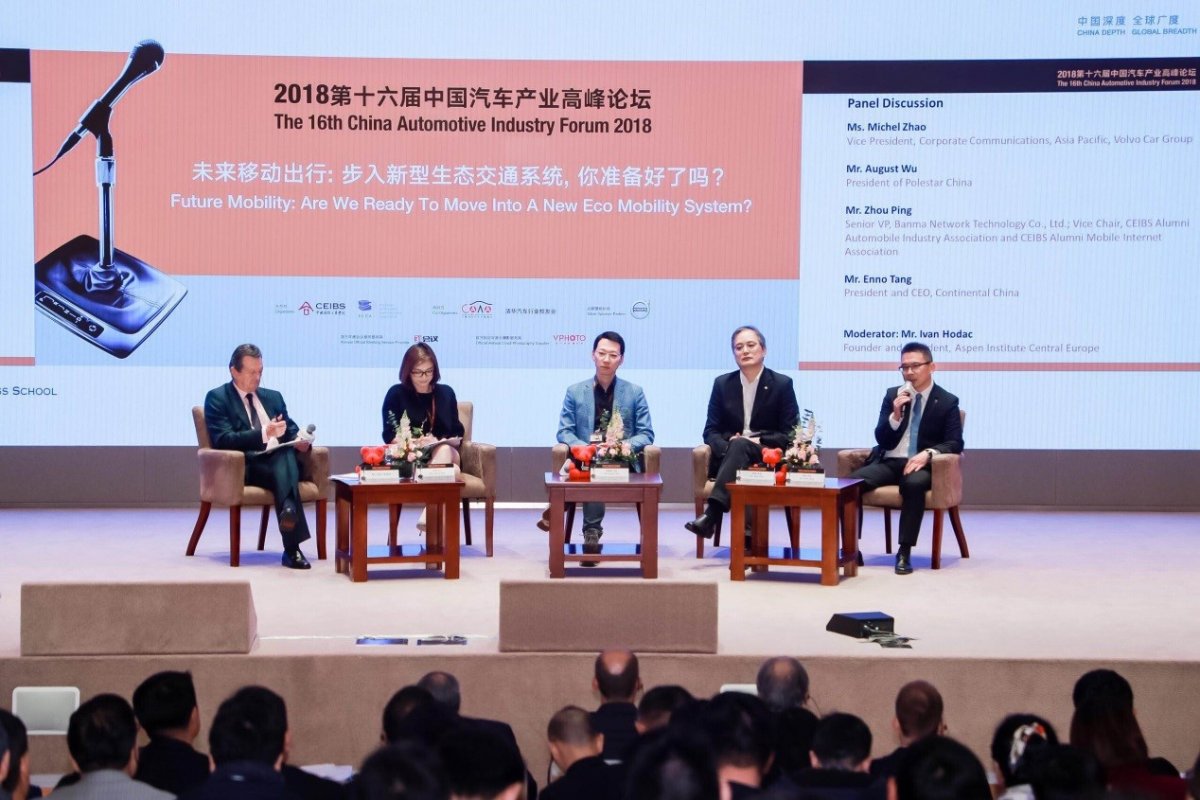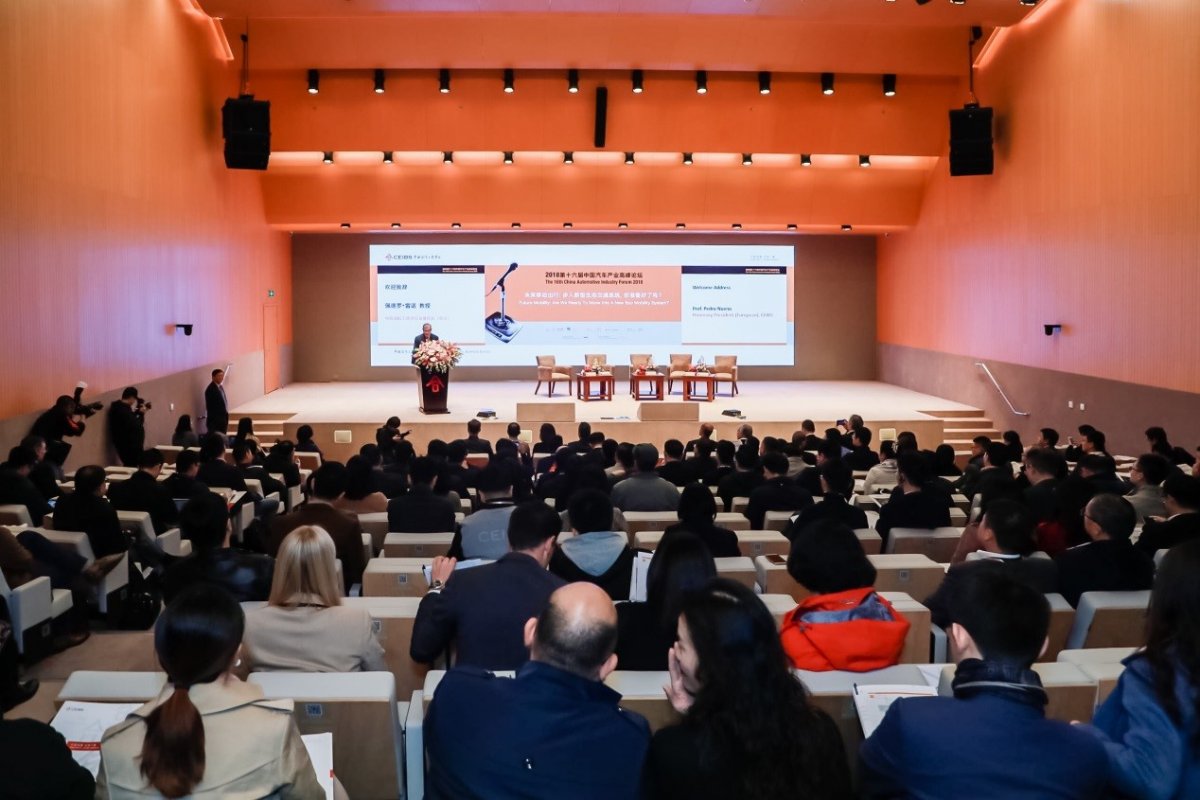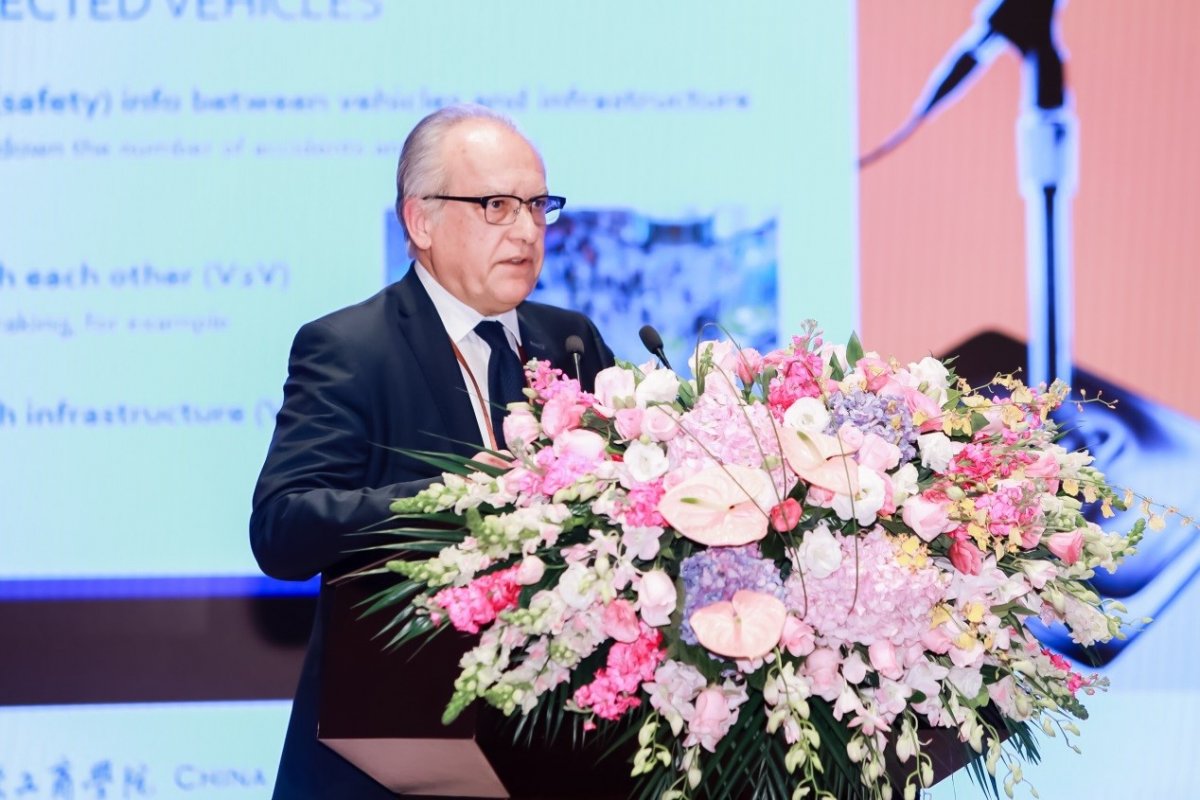Challenges and Opportunities in Future Mobility - 16th China Automotive Industry Forum
October 27, 2018. Beijing – Challenges and opportunities in future mobility was the focus of discussions during the 16th China Automotive Industry Forum 2018, co-hosted by China Europe International Business School (CEIBS) and the European Automobile Manufacturers Association (ACEA). It was held at the CEIBS Beijing campus today, bringing together government officials, prominent scholars, and industry leaders in the field of mobility for an in-depth discussion. There were more than 200 guests at the event.
CEIBS Honorary President Professor Pedro Nueno and Lou Zhouren, President of the CEIBS Alumni Auto Industry Association, delivered welcome speeches, while Xu Dingbo, the Essilor Chair Professor in Accounting at CEIBS, chaired the event.
Matthew Baldwin, Deputy Director of the European Commission; Erik Jonnaert, Secretary General of the ACEA; Dong Yang, Executive Vice President of the China Association of Automobile Manufacturers; along with executives and experts from many domestic and international mobility fields, including Volvo Cars, Polestar, Continental AG, Man, Aeromobil, eGT, G7, IBM, and Banma Network, were among the invited speakers.
Mobility facing multiple challenges
The mobility industry is currently facing numerous uncertainties, which have brought many challenges its development. According to event speakers, these are some of the biggest challenges:
First, infrastructure and energy supply have become bottlenecks and have limited rapid development. In China, for example, the number of cars is far below that of driver’s license holders, and car ownership per thousand people is lower than the global average. Tang En, President and CEO of Continental China, says he believes that, limited by infrastructure and energy supply, “car ownership in China is unlikely to grow rapidly.”
Second, in terms of mobility, technological progress has changed the business model and consumer mind-set. “The mobility field is becoming electrified, intelligent, networked, shared, and lightweight, and breakthroughs in key technologies have placed higher demands on the auto industry,” Lou Zhouren pointed out in his speech. The rise of new technologies, such as new energy, car networking, and unmanned driving, has also had a big impact on the traditional auto industry – not just technically, but also in terms of changes in the overall market landscape. “The consumer mind-set and business model have completely changed. Cars can no longer be viewed as a traditional travel tool, but must instead be treated with richer connotations,” said Wu Zhenhao, President of Polestar China.
Finally, relevant laws and regulations need to be improved. Industrial development should be guaranteed by sound laws and regulations. Dong Yang, Executive Vice President of the China Association of Automobile Manufacturers, stated that he believes that currently the fault-tolerance of relevant domestic laws and regulations is limited and there is still room for further improvement. For example, some regulations in the Road Traffic Law and Surveying and Mapping Law should be adjusted or modified according to actual situations.
Innovation: solution to bottleneck
In the face of restrictions and booming new technologies, can auto enterprises take the initiative in development and find a way to break the bottleneck?
Zhao Qin, Vice President of Corporate Communications of Volvo Cars in the Asia-Pacific region, believes the answer is yes, and that the way to break the bottleneck is through innovation. She stressed that “real innovation is not just a breakthrough of a single product or a certain technology, but a systematic combination along with a corresponding business model and even the development of an entire society. Such innovation is efficient and valuable.”
One type of innovation is to integrate with the internet to assist with user operation. “Traditional cars are more like offline products, and they are difficult for users to operate, but the internet can help a lot. Of course, ‘internet people’ must first become ‘car people’ and learn to respect the auto industry,” said Zhou Ping, Senior Vice President of Banma Network Technology Co., Ltd.
Another form of innovation is to produce electric vehicles. According to Wu Zhenhao, President of Polestar China, there are already over 400 electric vehicle companies in China, all of which are trying to innovate in related fields. However, he stressed that each industry has its own developing rules, and that it is not necessarily a good thing to go with the tide, which may lead to excessive competition and a waste of resources. For example, installing charging stations is not very profitable and requires government cooperation. It will take a certain amount of time to get the volume needed, so extensive use of electric cars still has a long way to go.
Automatic driving: the future
Another point on which speakers agreed is that automatic driving will play a big role in future mobility and that automatic driving can reduce the number of casualties caused by traffic accidents.
Citing data from the World Health Organisation, Matthew Baldwin, Deputy Director of the European Commission said, 1.3 million people die from road accidents every year, more than 90% of which are caused by human factors. Unmanned driving can effectively address this problem, he argued. “Unmanned driving may lead to an increase in the rate of injuries in road accidents for a period of time, but a great decrease in the mortality rate, and many people’s lives can be saved,” he said.
Erik Jonnaert, Secretary General of the ACEA, agreed. “Automatic driving is a big change. By using technology to reduce the risks caused by human mistakes, we can greatly reduce the casualty rate,” he said. “Currently, many companies are making attempts in this regard, and hopefully we’ll see the realisation of automatic driving by 2030.”
Xu Changming, Deputy Director of the State Information Center, also said he believes that automatic driving has broad prospects in China. Chinese consumers are highly receptive to unmanned driving, so there is a huge potential demand. Moreover, Chinese cities are large and densely populated. These characteristics indicate that China is suitable for developing unmanned driving.
However development is still slow due to technical constraints. Wu Zhenhao, President of Polestar China, believes that unmanned driving will be commercialised by 2025, but it will take at least ten more years before it is widely accepted and used.
Smart logistics: future of cargo transportation
At the forum, guests also discussed the status quo and future of human mobility, as well as changes and innovations in cargo transportation.
Tang Tianguang, Chairman of the Technical Committee and President of the Intelligent Driving Business Group of Manbang Group, stated that the biggest problem with current cargo transportation is inefficiency, caused mainly by two factors: first, truck operations are highly dispersed, making it difficult to form a global optimal solution; and, second, the efficiency of bicycle use is not high.
Song Xujun, Vice President and CSO of G7, said that besides inefficiency, safety accidents are also a big problem. Major traffic accidents related to cargo transportation make up a high proportion of these, up to 100,000 each year, half of which cause death or serious injury to drivers.
To solve the current problems, Song Xujun noted that changes and innovations are needed to promote coordinated transportation and to upgrade transportation modes. “I believe that only if we upgrade transportation modes and improve transportation efficiency and safety through smart logistics, can we change the status quo of cargo transportation and develop it better in the future,” he said.
The China Automotive Industry Forum is a signature CEIBS event that provides a platform for frank discussion on transformations within the country’s auto industry and how these impact and are impacted by changes in the rest of the world. The event has been staged for almost two decades.




















